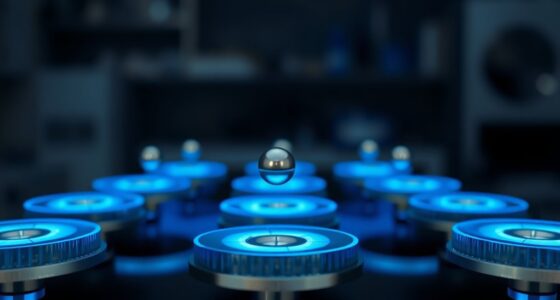Swarm robotics will transform disaster response by letting large groups of small, autonomous robots work together to quickly locate survivors, assess hazards, and map complex environments. These robots operate without central commands, adapting rapidly to unpredictable conditions like debris and unstable structures. They can cover large areas efficiently, providing real-time data to improve rescue efforts. If you want to discover how this technology continues to evolve and shape future emergencies, there’s more to explore.
Key Takeaways
- Enable rapid, adaptive search and rescue in complex, unpredictable disaster environments without centralized control.
- Provide real-time environmental mapping and hazard assessment to improve responder safety and decision-making.
- Ensure resilience and scalability, allowing large swarms to operate effectively despite communication disruptions or unit failures.
- Detect secondary hazards early and monitor ecological changes for comprehensive disaster management and recovery.
- Offer cost-effective, reliable solutions that accelerate response times and enhance overall safety and efficiency.

Swarm robotics is transforming disaster response by enabling rapid, flexible, and efficient search and rescue operations. When disaster strikes—whether an earthquake, flood, or chemical spill—you can deploy a swarm of robots that work together seamlessly, without needing a central command. These robots adapt quickly to unpredictable environments, steering through debris, unstable structures, and inaccessible areas. Their ability to operate collaboratively allows you to cover large zones swiftly, gathering real-time data that can substantially speed up locating survivors trapped beneath rubble or in hazardous spots. Equipped with thermal imaging, drone swarms can detect heat signatures of people, making it easier to pinpoint their locations even in chaotic scenes. This technology not only accelerates rescue efforts but also minimizes risks to human responders, as robots can enter dangerous locations first, evaluating hazards before humans arrive.
Swarm robots enable swift, adaptive search and rescue, reducing risks and speeding disaster response efforts.
In addition to search and rescue, swarm robotics enhance hazard assessment and mapping. They can rapidly create detailed maps of disaster zones, providing up-to-date information about structural damage, temperature variations, gas leaks, or other environmental threats. Autonomous navigation allows these robots to explore wide, complex terrains beyond what a human team could manage. As they collect environmental data, emergency responders gain essential insights that inform decision-making, helping to prioritize areas for rescue or stabilization efforts. Continuous monitoring by these robots allows the evaluation of ongoing risks, ensuring responders remain aware of changing conditions without risking their safety. This real-time environmental intelligence supports smarter, more targeted disaster responses. Additionally, advancements in autonomous coordination are making these systems more resilient and adaptable in unpredictable settings.
The resilience and scalability of swarm systems make them particularly valuable in disaster scenarios. Even if some units fail, the remaining robots continue their tasks thanks to distributed control and redundancy. Large numbers of small robots can be deployed quickly to cover extensive areas, and their modular design means you can adjust the size of the swarm based on the scope of the disaster. Autonomous coordination reduces reliance on damaged communication infrastructure, ensuring the system works effectively despite compromised networks. This adaptability means the swarm can evolve with the situation, scaling up or down and reassigning tasks dynamically without human intervention. Additionally, ongoing advancements in energy efficiency are making these systems more sustainable for prolonged missions, further enhancing their usefulness in disaster response.
Post-disaster, swarm robots play an essential role in environmental monitoring. They can identify secondary hazards like wildfires or chemical leaks early, tracking ecological changes in real-time to prevent further damage. Monitoring ecosystems such as forests or wetlands helps evaluate the disaster’s long-term impact, guiding recovery and restoration efforts. Their continuous sensing capabilities support ongoing risk assessments, making them indispensable for building resilience against future events. When integrated with human rescue teams, these robots enhance situational awareness, providing crucial visuals and sensor data that improve coordination. They extend the reach of emergency responders, relay critical information on survivor health and structural stability, and help allocate resources more precisely. This partnership between robots and humans enhances rescue accuracy while reducing human exposure to danger. The development of autonomous multi-robot systems ensures a more coordinated and effective disaster management strategy.
Using multiple small, inexpensive robots makes swarm systems cost-effective and reliable. They can operate in environments where traditional equipment might be impractical or too risky. By combining their collective efforts, swarm robotics not only speeds up disaster response but also creates safer, smarter, and more adaptable rescue operations—changing the way we confront and recover from emergencies.
Frequently Asked Questions
How Do Swarm Robots Communicate in Disaster Environments?
You might wonder how swarm robots communicate in disaster environments. They rely on wireless methods like infrared, Bluetooth, radio signals, and visual markers to share information quickly and autonomously. Without existing infrastructure, they form ad-hoc, decentralized networks that self-organize, ensuring reliable data exchange. This approach allows them to coordinate, share updates, and adapt to changing conditions, making rescue efforts more efficient and resilient despite obstacles and interference.
What Are the Limitations of Swarm Robotics in Rescue Missions?
Imagine a flock of birds struggling against a storm—that’s what swarm robotics face in rescue missions. Your robots depend on fragile power sources, fragile communication links, and limited AI adaptability amid debris and harsh environments. They’re costly to deploy and maintain, and ethical questions cloud their use. Environmental hazards and mechanical stresses threaten their operation, making it clear that despite their promise, swarm robots still grapple with significant technical, operational, and ethical hurdles.
How Cost-Effective Are Swarm Robots Compared to Traditional Methods?
You might wonder how cost-effective swarm robots are versus traditional methods. They can lower expenses by reducing manpower, speeding up rescue efforts, and providing real-time data, which cuts delays. Although initial development costs are high, ongoing operation and maintenance tend to be cheaper because of modularity and scalability. Plus, they decrease risks to human responders, potentially saving costs related to injuries and long-term recovery, making them a smart investment overall.
Can Swarm Robotics Operate Autonomously Without Human Oversight?
Imagine a swarm of robots searching a collapsed building after an earthquake. You might wonder if they can operate fully on their own. While they can autonomously coordinate, adapt, and cover large areas, complete independence isn’t yet feasible. Human oversight remains essential for ethical decisions and complex judgments. Advances are making fully autonomous operations possible, but cautious supervision ensures safety and effectiveness in disaster response scenarios.
What Safety Protocols Are in Place for Swarm Robot Deployment?
You should know that safety protocols for swarm robot deployment include continuous monitoring for unusual behaviors and near-miss incidents, so you can assess risks in real time. You’ll rely on decision-support protocols to decide if investigations can happen without stopping operations or if shutdowns are necessary. Procedures are in place for quick extraction or shutdown of robots to prevent harm, and thorough accident investigations are conducted to improve safety measures before redeployment.
Conclusion
You’ll see how swarm robotics revolutionize disaster response by acting swiftly, adapting dynamically, and coordinating seamlessly. You’ll witness teams that learn together, react together, and recover together. With each robot working in harmony, you’ll realize the potential for safer rescues, faster recoveries, and more resilient communities. As these systems evolve, you’ll understand that the future of disaster response lies not just in technology, but in collaboration, innovation, and the unstoppable power of collective effort.










